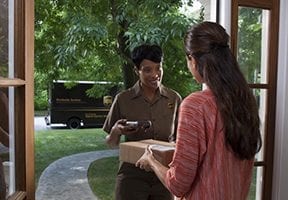Over 2 million Google searches each month in the United States include the phrase “free shipping.” Most online merchants have at least considered offering it. It’s a tough decision because shipping is expensive — Amazon’s shipping expense was $16.2 billion in 2016, over 17 percent of its total order value.
How can a retailer afford an additional 15 to 20 percent expense?
The good news is that you can.
Begin with a simple A/B test, in which a random sample of shoppers — 10 to 50 percent — is offered free shipping. Compare the control group with the test group to see the change.
Then, track three outcomes to determine the real cost of offering free shipping.
- Change in conversion rate. For example, a change from 5 percent to 6 percent is a 20 percent increase, or 1.2 expressed as a decimal. In the equation below, it’s variable A.
- Change in average order value. An AOV improvement from $50 to $51 is a 2 percent increase, or 1.02 expressed as a decimal — variable B, below.
- Change in gross margins. If the control group gross margin is 50 percent, and the test group gross margin is 35 percent, then the gross margin decrease is 30 percent: -15% ÷ 50% = -30%. This is -0.3 expressed as a decimal. It’s variable C, below.
Next, compute the percentage change in profit from offering free shipping, as follows.
% Change in profit (x) = [(A * B * (1+ C)) – 1] * 100
x = [(1.2 * 1.02 * (1 + (-0.3))) – 1] * 100
x = -14.3%
The change in profit from free shipping in this case is -14.3 percent.
What follows are seven strategies and tactics to turn free shipping from a -14.3 percent cost center into a profit increase.
7 Ways to Profit from Free Shipping
Set minimum order value. By adding a minimum threshold for free shipping, you can increase AOV because shoppers will have an incentive to increase basket size. You can also reduce the negative impact on margins because free shipping will be offered on fewer orders, and thus reduce situations where shipping cost represents more than 20 percent of the total order value.
Step 1: Choose a threshold. A good starting point is to add 10 to 15 percent to your current AOV. For example, if AOV is $50, offer free shipping on orders over $55
Step 2: Run the A/B test again. Your results could look like this:
- Conversion rate increased from 5 percent to 5.5 percent — 1.1, variable A.
- AOV increased from $50 to $57.50 — 1.15, variable B.
- Gross margin declined from 50 percent to 43 percent — -.14, variable C.
Now, the change in profit from free shipping is +8.8 percent:
% Change in profit (x) = [(A * B * (1+ C)) – 1] * 100
x = [(1.1 * 1.15 * (1 + (-0.14))) – 1] *100
x = 8.8%
Step 3: Supersize it. Adding a minimum of $55 for free shipping increases profit by 8.8 percent. Thus, we should heavily promote it. Here are three ideas.
- “You almost qualify.” When shoppers add an item to the cart, inform them how much more they need to spend to qualify for free shipping
- “Take advantage of your free shipping.” Once free shipping is earned, remind shoppers that they can take advantage of the free shipping to buy more.
- “Look how much you saved!” Remind shoppers at checkout how much money they are saving with free shipping
Use only ground shipping. Change the equation by offering free shipping only via your least expensive shipping option, such as USPS Flat Rate Boxes or UPS Mail Innovations. The promotion for this could be: “Free economy shipping on orders of $55 or more.”
According to 2017 survey by Internet Retailer and Bizrate Insights, nearly 90 percent of online shoppers say they are willing to wait longer for delivery of an order in exchange for free shipping. Most shoppers are likely to choose the free shipping option.
By using only ground shipping, you could cut your free shipping expense by more than half.
Offer low flat-rate shipping. Offer a flat-rate shipping charge on all orders. Amazon Prime Pantry does this well by leveraging consumer psychology to drive basket sizes up.
This approach has many advantages. Customers cover shipping expense on smaller, lower margin orders. Shoppers are incented to buy more, since additional items ship for free. As the order size increases, overall gross margin goes up, covering the incremental shipping cost.
Include shipping costs in product prices. Consider the effect on conversion rates from these two offers:
- Option 1: $30 + $5 shipping charge.
- Option 2: $35 with free shipping.
Bill D’Alessandro, of Rebel CEO, a consulting firm, ran this very test for a skincare product. The conversion rate for option 2 was twice that of option 1. This approach can work well for items that are unique and hard to price shop across multiple sites.
How do you include shipping costs in item prices? One approach is to change the pricing of items below the free shipping threshold to include a portion of expected shipping cost.
Say a merchant offers free shipping for orders of $75 or more. For a $25 item, add 33 percent ($25/$75) of the shipping cost to the item price. For a $10 item, add 13 percent ($10/$75) of the shipping cost to the item price.
The $25 item would now be offered at $28. The $10 item now has a price of $11.30. You still offer free shipping, but you’ll recoup a portion of the costs. Customers may prefer to pay $11.30 with free shipping versus $10 with $1.30 shipping.
Exclude items from free shipping. Reduce the negative margin impact of free shipping by:
- Offering free shipping only on high volume items with low shipping costs.
- Excluding low margin items from free shipping altogether.
- Excluding heavy and bulky items with high shipping costs from free shipping.
Substitute service types. If you are offering free ground shipping, and charging an additional fee for expedited 2-day shipping, avoid displaying on your website the carrier name and specific service type that you intend to use.
In many cases, you’ll be able to use economical ground shipping to meet even the 2-day shipping requirements for expedited orders. For deliveries in close proximity to your distribution centers and drop shippers, for example, you can ship using the cheapest ground option and still meet the delivery window for some of your expedited 2-day orders and pocket the savings.
Sell via Amazon Prime and FBA. Gain access to over half of U.S. households by offering select products through Amazon Prime while using Fulfillment by Amazon to cut fulfillment costs. While FBA is certainly not free for merchants, some find that the efficiencies and volume gained through Amazon Prime and FBA can cover the cost of free shipping.
Not a Cash Sink
In short, free shipping doesn’t have to be a cash sink. Smart retailers of all sizes use free shipping as a lever to increase conversions and average order values while minimizing its negative impact on profits.
Moreover, free shipping can also reduce customer service costs for returns. Customers often request to be reimbursed for shipping when returning an item. But there’s nothing to reimburse on free shipping!





